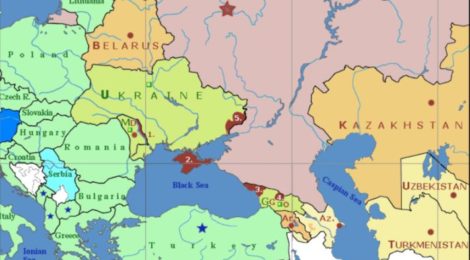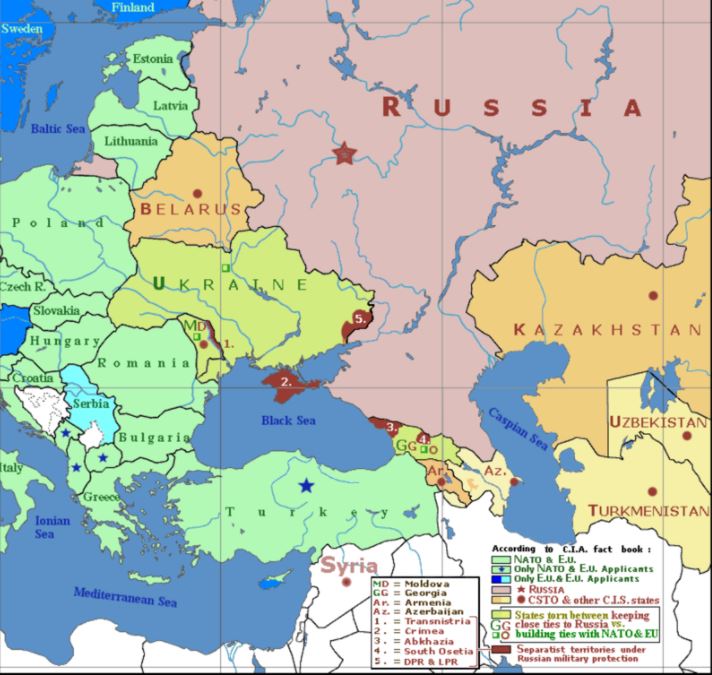
Crisis in Eastern Europe 2021-Why America Needs to Help Ukraine and Poland vs Russia
Crisis in Eastern Europe-Why America Needs to Help Ukraine and Poland vs Russia
Some people seem confused about the basic purposes of American foreign policy, especially in regards to how we deal with Russia. A television commentator, Tucker Carlson, had to have some simple truths explained to him by a Republican Congressman as to why the United States is not helping Vladimir Putin invade and dominate our allies, specifically Ukraine and Poland. This Eastern European crisis involving Russia, Ukraine, Poland, and Belarus, is all part of a connected crisis brewing along the periphery of the old Soviet empire.
Stating that he was “Totally confused,” Mr. Carlson went on to try to validate Putin’s aggression by saying, “Why would we take Ukraine’s side and not Russia’s side?”
How is it that Tucker Carlson is ok with Russia’s authoritarianism and territorial grabs, but is not ok with Chinese authoritarianism and territorial grabs? Could it be because his buddy Vlad is NOT Asian? Hmmm… | https://t.co/D5AqhSXTCA
— State of the World (@historyguycom) November 13, 2021
The Congressman went on to school Mr. Tucker in why the United States supports Ukraine (it is a democracy, Russia is not, and Ukraine is a strategic ally and friend), despite Tucker Carlson’s pretty realistic look of being confused by the very idea the U.S. should support a fellow democracy against aggression.
So, what is actually going on in Eastern Europe? It is now looking like a bigger issue than just what happens to Ukraine. Recently, Russian troops have massed along the Ukrainian border, while at the same time, Russian paratroopers have entered Belarus, which is a Russian ally, supposedly to defend Belarus from Poland and NATO.

Map of Eastern Europe Conflict Zones Source: Wikipedia
Poland and Belarus, along with the Baltic States of Lithuania and Latvia, are currently engaged in a border issue related to Middle Eastern refugees who Belarus has flown in, bused to the border, and then sent into Poland and neighboring states, thereby creating an artificial immigration crisis.
This is all part of Putin’s history of asymmetric warfare. He is provoking instability in the Eastern European members of NATO, where immigration is a hot-button issue, in a clear attempt to destabilize the pro-Western governments in these nations, while simultaneously putting military pressure on Ukraine.
A bit of history here regarding who is who, and who hates who in this Eastern European crisis.
Russia vs. Poland History
Poland and Russia have a long history of war and hostility, with Poland being under Russian rule from the late 1770s up to the end of World War One in 1918. Poland then had to fight off a Russian Communist army in 1920 to ensure independence. In 1939, Russia, allied then with Hitler’s Germany, invaded and conquered Poland again. From World War Two until the end of the Cold War in the late 1980s, Poland, while technically independent, was a satellite of Soviet Russia, having to endure hosting Russian troops, and aligning her defense and foreign policies to the Commuist Russian yoke. Poland and the Polish people have a very high interest in not becoming a victim of Russian aggression again.
Belarus Crisis and History
Belarus became independent in the early 1990s with the fall of the Soviet Union. Prior to that, Belarus (also known as White Russia) was a part of the old Czarist Russian Empire, and then part of the Soviet Union. Since independence, Belarus has been ruled by the authoritarian President Alexander Lukashenko, who, prior to the USSR’s end, had been an official in the Soviet government (alongside his buddy, Vladimir Putin). He has been re-elected in every election since 1994, winning the most recent one, in 2020, through clear voter fraud and cheating. Massive political demonstrations rocked Belarus for months after that election, but Lukashenko maintained his hold on power, in part with the support of Putin’s government. Belarus is basically now a Russian satellite.
Ukraine Crisis and History
Like Belarus, Ukraine was formerly part of the old Czarist and Soviet empires, gaining independence with the fall of the Soviet Union. At the end of World War One, Ukraine enjoyed a brief period of independence until invaded by Communist Russian armies, and remained a part of the Soviet Union until that communist dictatorship fell. In 2014, Russia invaded and annexed Ukraine’s Crimean Peninsula, and prompted a secessionist revolt in the eastern Donbass region of Ukraine. These separatists were ethnic Russians living in that part of Ukraine. Russian military forces aided these rebels, in effect invading Ukraine. The Donbass War has gone on since then, with periods of truce, and periods of conflict.
Recently, Russian military forces have assembled along the Ukraine border, with at least 100,000 Russian troops and their equipment spotted in locations in the border area.
United States and NATO Response to the Eastern European Crisis
The United States, NATO, and the European Union all express alarm over these related border issues in Eastern Europe. Vladimir Putin’s undemocratic regime, allied with the equally authoritarian regime in Belarus, are actively trying to undermine Ukraine, Poland, and the rest of Europe. This may all be part of a long game by Moscow to inflate problems and try to cause unrest and splits among the Western allies, or it could presage actual military aggression. The United States, Britain, France, and other NATO members are taking this seriously, with reports that 600 British troops are on standby to deploy to Ukraine, while U.S. Navy ships in the Black Sea draw Russian ire.
This is a serious situation. Wars have begun through design or through accident when nations confront each other. With ongoing political unrest in the United States, continued economic impacts from the COVID pandemic, and right-wing unrest in Eastern Europe (much of it around immigration by refugees), Putin may see this a prime time to grab land and increase Russian power, and hence his own status. Russia is dealing with a surge in COVID cases, and a slowing economy. Dictators have long recognized that foreign adventures can distract a restive populace from domestic issues. This may also be a motivating factor for both Putin and Lukashenko.
The question of what America, and the other NATO allies should do in this crisis is clear. We see democracies in Ukraine and Poland being threatened by authoritarian regimes in Russia and Belarus. Poland is a NATO member, while Ukraine seeks NATO membership. Add to this the fact that Russia is a bad actor on the international stage and actively sees itself as a near-peer competitor to the U.S. If America let’s Russia get away with aggression here, then other bad actors, specifically China, North Korea, and Iran, will also see the advantages of challenging American resolve. That makes the world a much more dangerous place for everyone. That is a lesson that talking heads like Tucker Carlson should think about before espousing pro-Russian propaganda on their shows. America must stand for democracy and against authoritarian aggression, whether the potential foe is China, Iran, or, in this case, Russia.
Sources:

I was quite surprised by Tucker Carlson feelings about Russia. I’m not an expert but I did have a young lady from Belarus work for me years ago. I also got to know her best friend who was from Ukraine. My Belarusian friend told me how their president decided he wanted to remain president and cancelled elections! I couldn’t believe it! But then she explained they were little Russia. What I didn’t know was that Ukraine was not ruled by a dictator. Now I’m very worried for both my friends. I haven’t heard from them. Last posts on Facebook were during most recent uprisings which wasn’t very recent.
I pray that the good people of both countries will be safe and a war can be averted. I’m not real confident with this administration after the botched exit from Afghanistan.